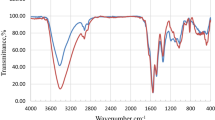Abstract
In this work, a new and highly efficient method of surface-initiated free radical graft-polymerizations on the surfaces of silica gel particles was put forward, and the graft-polymerization of methacrylic acid (MAA) was conducted. This method was convenient, feasible and highly effective. Coupling agent γ-mercaptopropyltrimethoxysilane(MPTS) was first bonded onto the surfaces of silica gel particles, obtaining the modified particles MPTS-SiO2, onto which mercapto groups were chemically attached, so a redox initiation system of graft-polymerization was constituted by the mercapto group on the surfaces of MPTS-SiO2 particles and the cerium (IV) salt in the solution. And then the surface-initiated free radical graft-polymerization of MAA on the surfaces of silica gel particles was carried out, resulting in the grafted particles PMAA/SiO2 with a very high grafting density (35 g/100 g) of PMAA. The grafted particles PMAA/SiO2 were characterized by infrared spectrum (FTIR), scanning electron microscope (SEM) and thermogravimetric analysis (TGA). The effects of the main factors on the new surface-initiated graft polymerization were emphatically examined, and the corresponding mechanism of the graft-polymerization was investigated in depth. The experimental results show that the mercapto group-cerium salt system analogous to the hydroxyl group-cerium salt system, can also effectively initiate vinyl monomers to be graft-polymerized on the surfaces of solid particles, and furthermore, it is a highly effective surface-initiated graft-polymerization method. In this graft-polymerization system, several factors such as sulfuric acid concentration, the used amount of cerium salt and the reaction temperature affect the grafting density greatly. For the graft-polymerization of MAA, the appropriate reaction conditions are as follows: reaction time of 3 h, reaction temperature of 50 °C, cerium concentration of 5.0 × 10−3 M, acid (H+ ion) concentration of 0.15 M and MAA concentration of 0.5 M.











Similar content being viewed by others
References
Li Y, Zhou W-H, Yang H-H, Wang X-R (2009) Talanta 79:141–145
Helminen J, Paatero E (2006) React Funct Polym 66:1021–1032
Guo T-Y, Liu P, Zhu J-W, Song M-D, Zhang B-H (2006) Biomacromolecules 7:1196–1202
Sanchez C, Lebeau B, Chaput F, Boilot J-P (2003) Adv Mater 15:1969–1994
Kaneko Y, Imai Y, Shirai K, Yamauchi T, Tsubokawa N (2006) Colloids Surf A 289:212–218
Sun M, Qiu H-D, Wang L-C, Liu X, Jiang S-X (2009) J Chromatogr A 1216:3904–3909
B-j G, Kong D-l, Zhang Y (2008) J Mol Catal A: Chem 286:143–148
Kaneko Y, Imai Y, Shirai K, Yamauchi T, Tsubokawa N (2006) Colloids Surf A Physicochem Eng Asp 289:212–218
Shao D-D, Xu K-K, Song X-J, Hu J-H, Yang W-L, Wang C-C (2009) J Colloid Interface Sci 336:526–532
Liu P, Wang T-M (2007) J Hazard Mater 149:75–79
Zong S-Z, Cao Y, Zhou Y-M, Ju H-G (2007) Biosens Bioelectron 22:1776–1782
El Harrak A, Carrot G, Oberdisse J, Jestin J, Boué F (2005) Polymer 46:1095–1104
Chinthamanipeta PS, Kobukata S, Nakata H, Shipp DA (2008) Polymer 49:5636–5642
Gromadzki D, Makuška R, Netopilı’k M, Holler P, Lokaj J, Janata M, Štěpánek P (2008) Eur Polym J 44:59–71
Wang Y-M, Wang Y-J, Lu X-B (2008) Polymer 49:474–480
Parnell AJ, Martin SJ, Dang CC, Geoghegan M, Jones RAL, Crook CJ, Howse JR, Ryan AJ (2009) Polymer 50:1005–1014
Gao B-J, Wang J, An F-Q, Liu Q (2008) Polymer 49:1230–1238
Hu S-W, Wang Y, McGinty K, Brittain WJ (2006) Eur Polym J 42:2053–2058
Prucker O, Rühe J (1998) Macromlecules 31:602–613
Bachmann S, Wang HY, Albert K, Partch R (2007) J Colloid Interface Sci 309:169–175
Munro NH, Hanton LR, Moratti SC, Robinson BH (2009) Carbohydr Polym 77:496–505
Jin S-P, Liu M-Z, Chen S-L, Gao C-M (2008) Eur Polym J 44:2162–2170
Lee H, Boyce JR, Nese A, Sheiko SS, Matyjaszewski K (2008) Polymer 49:5490–5496
Behling RE, Williams BA, Staade BL, Wolf LM, Cochran EW (2009) Macromolecules 42:1867–1872
Riachi C, Schqwer N, Klok H-A (2009) Macromolecules 42:8076–8081
Yagci C, Yildiz U (2005) Eur Polym J 41:177–184
Fanta GF, Felker FC, Shogren RL (2004) Carbohydr Polym 56:77–84
Shantha KL, Harding DRK (2002) Carbohydrate Polymer 48:247–253
Gaffar MA, El-Rafie SM, El-Tahlawy KF (2004) Carbohydr Polym 56:387–396
Carrillo F, Defays B, Colom X (2008) Eur Polym J 44:4020–4028
Gao B-J, Hu H-Y, Guo J-F, Li Y-B (2010) Colloids Surf B 77:206–213
Deng B, Li JY, Hou ZC, Yao SD, Shi LQ, Liang GM, Sheng KL (2008) Radiat Phys Chem 77:898–906
Tang E, Cheng G-X, Ma X-L (2006) Powder Technol 161:209–214
Ngo VG, Bressy C, Leroux C, Margaillan A (2009) Polymer 50:3095–3102
Tsubokawa N, Hayashi S, Nishimura J (2002) Prog Org Coat 44:69–74
Hayashi S, Fujiki K, Tsubokawa N (2000) React Funct Polym 46:193–201
Bialk M, Prucker O, Rühe J (2002) Colloids Surf A Physicochem Eng Asp 198–200:543–549
Kaşgöz H, Özgümüş S, Orbay M (2001) Polymer 42:7497–7502
Author information
Authors and Affiliations
Corresponding author
Rights and permissions
About this article
Cite this article
Gao, B., Fang, L., Wang, X. et al. Constituting redox initiation system of mercapto-cerium salt and realizing highly effective graft-polymerization of MAA on surfaces of silica gel particles. J Polym Res 19, 4 (2012). https://doi.org/10.1007/s10965-012-0004-5
Received:
Accepted:
Published:
DOI: https://doi.org/10.1007/s10965-012-0004-5




